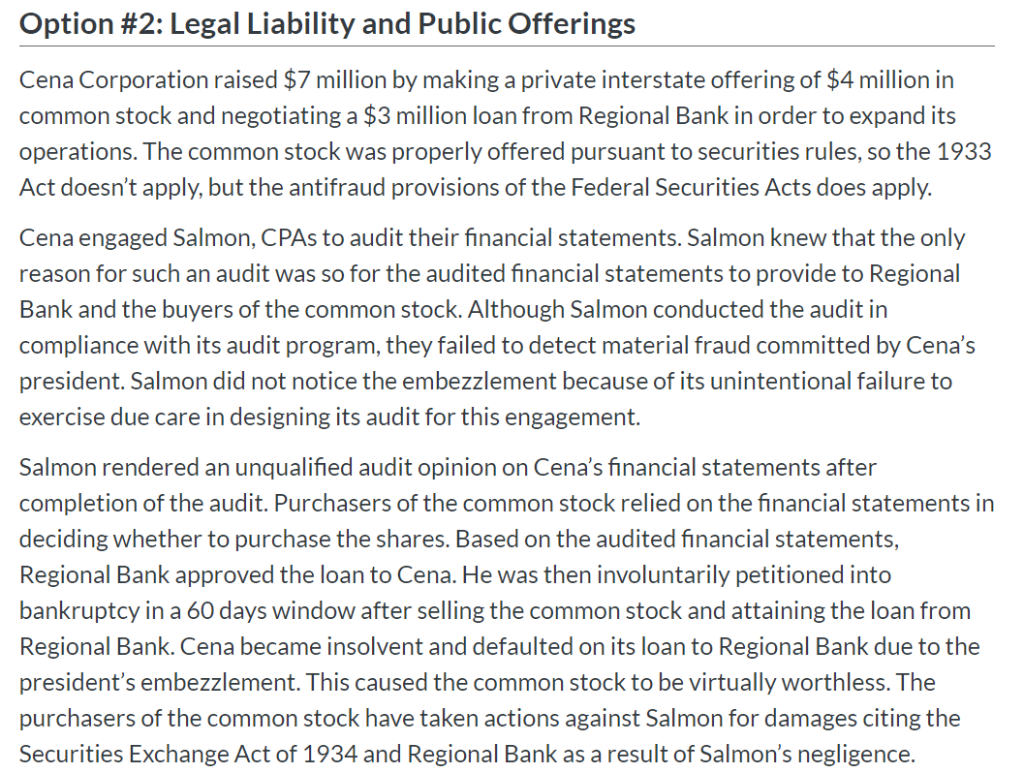

Option #2: Legal Liability and Public Offerings Cena Corporation raised $7 million by making a private interstate offering of $4 million in common stock and negotiating a $3 million loan from Regional Bank in order to expand its operations. The common stock was properly offered pursuant to securities rules, so the 1933 Act doesn't apply, but the antifraud provisions of the Federal Securities Acts does apply. Cena engaged Salmon, CPAS to audit their financial statements. Salmon knew that the only reason for such an audit was so for the audited financial statements to provide to Regional Bank and the buyers of the common stock. Although Salmon conducted the audit in compliance with its audit program, they failed to detect material fraud committed by Cena's president. Salmon did not notice the embezzlement because of its unintentional failure to exercise due care in designing its audit for this engagement. Salmon rendered an unqualified audit opinion on Cena's financial statements after completion of the audit. Purchasers of the common stock relied on the financial statements in deciding whether to purchase the shares. Based on the audited financial statements, Regional Bank approved the loan to Cena. He was then involuntarily petitioned into bankruptcy in a 60 days window after selling the common stock and attaining the loan from Regional Bank. Cena became insolvent and defaulted on its loan to Regional Bank due to the president's embezzlement. This caused the common stock to be virtually worthless. The purchasers of the common stock have taken actions against Salmon for damages citing the Securities Exchange Act of 1934 and Regional Bank as a result of Salmon's negligence. Required: a. Explain the merits of the actions commenced against Salmon by the common stock purchasers and by Regional Bank. What are the likely outcomes? Explain b. What if the purchasers of the common stock were able to bring suit under the 1933 Act and client filed a registration statement initially? How would you answer differ from the previous question? Explain. c. What are the differences between the Securities Exchange Acts of 1933 and 1934? Option #2: Legal Liability and Public Offerings Cena Corporation raised $7 million by making a private interstate offering of $4 million in common stock and negotiating a $3 million loan from Regional Bank in order to expand its operations. The common stock was properly offered pursuant to securities rules, so the 1933 Act doesn't apply, but the antifraud provisions of the Federal Securities Acts does apply. Cena engaged Salmon, CPAS to audit their financial statements. Salmon knew that the only reason for such an audit was so for the audited financial statements to provide to Regional Bank and the buyers of the common stock. Although Salmon conducted the audit in compliance with its audit program, they failed to detect material fraud committed by Cena's president. Salmon did not notice the embezzlement because of its unintentional failure to exercise due care in designing its audit for this engagement. Salmon rendered an unqualified audit opinion on Cena's financial statements after completion of the audit. Purchasers of the common stock relied on the financial statements in deciding whether to purchase the shares. Based on the audited financial statements, Regional Bank approved the loan to Cena. He was then involuntarily petitioned into bankruptcy in a 60 days window after selling the common stock and attaining the loan from Regional Bank. Cena became insolvent and defaulted on its loan to Regional Bank due to the president's embezzlement. This caused the common stock to be virtually worthless. The purchasers of the common stock have taken actions against Salmon for damages citing the Securities Exchange Act of 1934 and Regional Bank as a result of Salmon's negligence. Required: a. Explain the merits of the actions commenced against Salmon by the common stock purchasers and by Regional Bank. What are the likely outcomes? Explain b. What if the purchasers of the common stock were able to bring suit under the 1933 Act and client filed a registration statement initially? How would you answer differ from the previous question? Explain. c. What are the differences between the Securities Exchange Acts of 1933 and 1934








